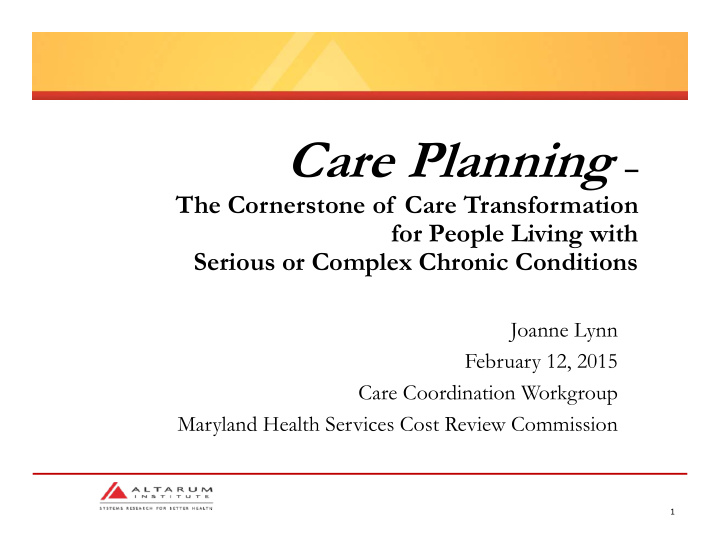



Care Planning – The Cornerstone of Care Transformation for People Living with Serious or Complex Chronic Conditions Joanne Lynn February 12, 2015 Care Coordination Workgroup Maryland Health Services Cost Review Commission 1
PERSON-CENTERED CARE PLAN 2
Steps in optimal care planning 1. Targeting who needs care planning – starting in Medicare – mainly frail, physically disabled, mentally disabled, ESRD, and end-of-life 2. Care Planning A. Current patient/family situation B. Likely future situation(s) with various strategies – and settle on relevant timeframe C. Patient/family priorities – hopes, fears, values – GOALS D. Negotiated, patient-driven care plan E. Available to those who need it, promptly 3. Evaluation and Feedback – system learning 4. Care plan use in system management – supply and quality issues for community 3
Details on Care planning elements A. Current patient/family situation 1. Medical and disabilities 2. Housing/food/transportation 3. Caregiving and personal care 4. Relationships, financing, and abuse/neglect 4
Details on care plan elements D. Negotiated, patient-driven care plan – including 1. Goals 2. Services and responsible party for each – and overall responsible party 3. Likely challenges and responses 4. Time for scheduled review 5. Available 24/7 to address urgent issues 6. Available appropriately to relevant service providers 7. Care team members, including patient and caregivers 5
Thus – the care plan is showing up Already a core commitment of (and requirement for) PACE (Program of all-inclusive care of the elderly), home care, and hospice Central to the new Chronic Care Coordination service (using new CCM code = ~$42/mo/person to physician delivering a set of chronic care coordination services) Thin version (for only a couple of days) in transitions and referrals in Meaningful Use 3 (proposed) 6
The Chronic Care Management Code List of Elements “typically included” in a Care Plan Problem list; expected outcome and prognosis; measureable treatment goals Symptom management and planned interventions (including preventive care) Community/social services Plan for care coordination with other providers Medication management Responsible individual for each intervention Requirements for periodic review/revision 7
Evaluation – for systems Sum up performance for individuals, examine outliers Feedback upstream – self-correcting process Use care plans to manage the service supply and quality Aggregate optimal and actual care plans for a population Geo-map home care services – meals, personal care, MDs, etc. Examine gap between optimal and actual Compare with past and with similar communities 8 8
To Start: Some Statewide Care Plan Strategies 1. Develop/acquire a standardized and user-friendly care plan tool and processes 2. Develop interoperability of EMRs 3. Share care plans within the care team 4. Give patients and families their care plans (electronically or on paper) 5. Create standards and infrastructure for Medicare’s Chronic Care Management services 6. Develop and implement metrics to evaluate and improve care planning 7. Create regional shared savings and gain sharing programs between and among hospitals, payers, and various providers 8. Develop regional/local initiatives to monitor and manage regional/local system supply and performance 9. Develop methods to aggregate care plans in a geographic area and develop system management metrics from the care plans 9
Recommend
More recommend